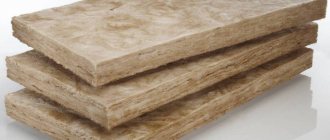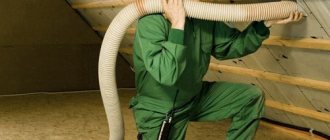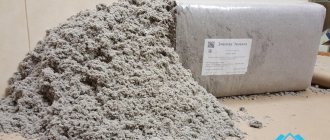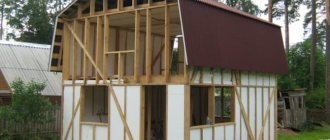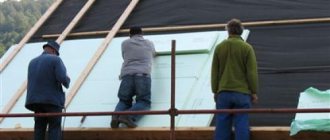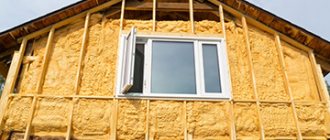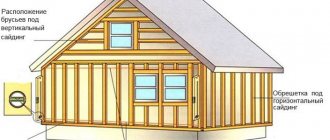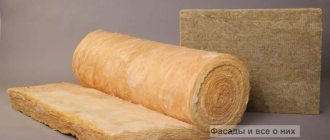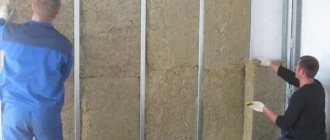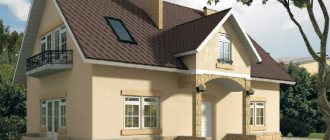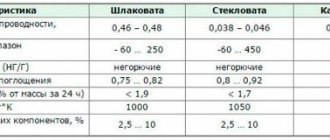Pros and cons, material characteristics
Stone wool is made from basalt by melting it and then blowing it with a strong stream of air. The result is a loose layer of material, which is then compacted on a conveyor. It goes on sale in the form of slabs and, very rarely, small-length rolls.
Advantages and disadvantages
Stone wool for insulating walls outside and inside the building stands out among competitors. She has many advantages :
- durability - service life of at least 50 years;
- resistance to high temperatures - withstands heating up to 1000oC;
- almost zero hygroscopicity;
- excellent thermal insulation properties;
- good noise absorption properties;
- does not serve as a base for the proliferation of fungus and mold;
- there are no restrictions on use as insulation;
- convenient transportation;
- simple installation;
- high resistance to alkalis, acids and salt solutions;
- good elasticity, which allows you to fasten it into the sheathing by surprise.
In addition, two more advantages of wool made from basalt fibers should be noted.
- The ability of the material to resist rodents.
- When external insulation is covered with decorative plaster and paint, and internal insulation is covered with wallpaper and paint, there is no need to install sheathing.
Among the disadvantages :
- high price;
- dust generated during work.
Material characteristics
The physical and technical characteristics of the material are presented by the following indicators:
- thermal conductivity - 0.035-0.042 W/(m K);
- average diameter of threads - 4-12 microns;
- fiber length up to 16 mm;
- density - 30-300 kg/m3;
- strength: compressive strength - 8-60 kPa (depending on density); for layer separation - 80 kPa; bending - 0.15 MPa.
The insulation can be used at temperatures from –190oC to +1000oC. You can read more about basalt insulation in the material “Review of stone (basalt) wool insulation.”
Insulation materials
241 votes
+
Vote for!
—
Vote against!
Sooner or later, each of us is faced with the need for construction or renovation, one of the pressing issues of which is thermal insulation. Its relevance is due to the exponentially growing costs of electricity and heating and related thoughts about saving energy resources, as well as excessive concern about the environmental safety of the building materials used, due to the emerging increase in cancer incidence. Despite the fact that the construction market offers the consumer a wide variety of insulation materials characterized by certain advantages, when considering the features of materials from this variety in the process of choosing insulation, they often give preference to basalt wool, the features of which will be discussed in this article.
Content
- Internal or external insulation: what to prefer?
- Scope of application of basalt wool: basic provisions
- Operational and technical characteristics of basalt wool
- Advantages of basalt wool
- Disadvantages of basalt wool and methods for leveling them
- Basalt wool: choice of manufacturer depending on the operating conditions of the structure
- How to insulate with basalt wool: basic recommendations
- Insulating a house with basalt wool: a step-by-step guide
Internal or external insulation: what to prefer?
As already mentioned, sooner or later the issue of saving energy resources arises. How to save on heating a house or apartment? In civilized countries, the answer to this question has long been found, the solution of which lies in the implementation of insulation of houses, cottages, apartments and other buildings. In addition, the feasibility of this insulation method has been fully proven, which is confirmed by the widespread consumption of this building material, which is in third place among building materials in the process of cost analysis for the construction of buildings.
Important! The advisability of insulation can be discussed in two cases: if you have purchased a new house that needs improvements to guarantee comfortable living, or if you are designing a new house from scratch.
Speaking about the advisability of various types of insulation, it should be noted that the opinions of specialists in this case vary. Some persistently confirm the feasibility of internal insulation, others, on the contrary, believe that the structure, first of all, should be subjected to external insulation, since the internal one is a rather complex process, the question of the feasibility of which is decided in each specific case.
Important! Beginners in the field of insulation often rely on the opinion of “experts” or advice on relevant forums and give preference to internal insulation, which subsequently causes condensation and mold to appear on the walls of the house. The reason for this is the use of cotton wool or dense foam, which, when installed on internal walls, prevents the walls from drying out, which always remain damp.
Disadvantages of internal insulation:
- The strength and low thermal conductivity of the insulation combined with high noise insulation characteristics, which cannot be compensated even due to the high cost of the material;
- The presence of seams at the junctions of the insulation reduces the performance characteristics of the material, making it insufficiently airtight;
- In the process of working with this heat-insulating material, small pieces break off from it, which contribute to raising a column of tiny basalt dust and necessitate the use of respirators or covering the surface of the insulation with a layer of waterproofing membrane;
- The high vapor permeability of the material makes it inappropriate to use insulation in some cases, such as insulating the foundation or basement floor, when basalt wool can be replaced with polystyrene foam.
Basalt wool photo
Scope of application of basalt wool: basic provisions
The use of basalt insulation is important in the process of construction and subsequent insulation of almost any building structure. It can be used to insulate roofs of any shape, as well as walls, partitions and ceilings. In addition, the use of basalt wool may be relevant where the feasibility of using other insulation is minimal. To verify this, let’s consider the main areas of use of basalt wool:
- Insulation of rooms characterized by high humidity (for example, baths or saunas);
- Use of ventilated type curtain facades, as well as “wet” facades during installation;
- Use as insulation for walls built from sandwich panels and made according to the principle of “layered masonry”;
- Insulation of ship cabins and other ship structures;
- Use for insulation of pipelines, the surface temperature of which varies from -120 to +1000 degrees;
- Basalt wool as a fireproof insulation prevents the fire of ventilation pipes and other building structures.
Important! The use of rigid mats made of basalt wool is especially important where exposure to both installation and operational loads exceeding permissible values is expected. If you plan to insulate a ventilated facade, experts recommend using basalt wool, consisting of two layers, each of which is characterized by a different density. In this case, a layer with a looser structure is located on the inside of the heat-insulating layer and is in contact with the surface of the wall, and the second, characterized by a denser texture, should be located on the outside, on the ventilation side.
Operational and technical characteristics of basalt wool
To make basalt wool, basalt and some related mineral rocks of the basalt group and close to it are used. To ensure greater fluidity of thin basalt fibers, the manufacturer includes from 10 to 35% limestone or charge into the melt, which helps transform the structure of the fiber and reduce its susceptibility to aggressive environmental factors, including high temperatures. Due to the inclusion of third-party components in the composition of such fiber, it is incorrect to call it basalt, and it is called “basalt mineral wool”. This fiber is called basalt super thin fiber (BSF). It is thinner and shorter (thickness 1-3 microns, length 50 mm).
Technical characteristics of mineral basalt wool:
- Thermal insulation material, which is based on the use of BDST, is characterized by resistance to vibration. During the production of basalt wool, it undergoes vibrothermal treatment at a temperature of 900 degrees, after which the loss in its mass remains minimal and does not exceed 0.35%, which is primarily due to long-fiber wool. In this regard, experts have come to the conclusion that the quality and performance characteristics of basalt wool directly depend on the length of its fibers. An equally important parameter is the degree and nature of crystallization, which helps maintain an optimal level of elasticity and strength characteristics.
- Basalt wool based on thin basalt fibers (BTV) is characterized by lower vibration resistance. During vibration for 3 hours at a temperature of 600 degrees, the mass loss from the initial state is at least 2%, however, when the temperature reaches 900 degrees, the mass loss increases to 12%. In this regard, the conclusion suggests itself that wool based on short fibers is less vibration-resistant.
- Having studied the technical characteristics of basalt wool, one cannot fail to note the absolute non-flammability of the material. Under the influence of high temperatures, there is no destruction of basalt wool fibers, which remain connected and demonstrate high strength.
- Thermal conductivity and hydrophobization of basalt wool. Due to the fact that basalt wool fibers do not retain moisture, it always remains dry and retains its thermal insulation characteristics. Hydrophobization is a natural obstacle to the accumulation of moisture, and therefore there is no increase in the total weight of the structure. This, in turn, prevents the occurrence of mechanical damage.
Important! Despite hydrophobization, the peculiarities of the chemical composition of basalt wool determine its insignificant hygroscopicity, the presence of which guarantees the stability of the thermophysical characteristics of the material, even despite the duration of its use.
Advantages of basalt wool
According to experts, basalt wool has many advantages compared to other thermal insulation materials. Let's look at what they are.
- The single-component nature of basalt wool is one of its main advantages, implying the use of only one rock in the process of its production - basalt. However, modern production technologies require the inclusion of a charge or limestone in its composition, which helps to increase the fluidity of the fibers. Despite this, experts admit that these features of its production may negatively affect the resistance of the heat-insulating material to high temperatures. It is important to know that basalt wool is a qualitatively new material, the production features of which allow its use as the main thermal insulator for residential and administrative buildings, as well as pipelines and refrigeration units;
- High heat and sound insulation qualities due to the low thermal conductivity of the material, which contributes to a significant reduction in financial costs for heating the room. The soundproofness of the material is due to its fibrous structure, which reduces the speed of propagation and subsequently dampens sound and vibration waves, converting them into thermal energy;
- As for high thermal insulation characteristics, they are achieved due to the air that is between the fibers and is characterized by a low thermal conductivity coefficient;
- An equally significant advantage of basalt wool is its long service life , which, according to experts, ranges from 30 to 40 years, but in practice demonstrates even higher performance;
- Resistance to chemically aggressive substances (organic oils, acids, alkalis and solvents);
- Water resistance of the material , which is achieved through the inclusion of specialized hydrophobic additives in its composition. The low moisture content in the structure of the material, in turn, helps to increase the thermal insulation characteristics of the material;
- Resistance to damage by mold and fungal microorganisms is one of the important qualities that are important for the insulation of residential premises;
- The high density of basalt wool slabs allows them to withstand increased mechanical loads, and also makes it possible to decorate the material with protective compounds;
- Weather resistance , implying the preservation of original performance characteristics under the influence of changes in temperature and humidity;
- Low specific gravity due to the fibrous structure of the material;
- Convenience of masonry , achieved through large square slabs that immediately cover large areas.
Disadvantages of basalt wool and methods for leveling them
Despite all the above advantages, basalt wool is characterized by certain disadvantages, which under certain conditions can be minimized. Let's look at what they are.
- The structural features of the material contribute to excessive moisture absorption, which reduces the thermal insulation characteristics of the material. How to deal with this disadvantage? Experts believe that the most optimal solution to this issue is foiling or lining an additional vapor barrier layer during the installation process. However, the latter option is less preferable, since the glue used for this reduces the fire resistance of the material. Another solution, the implementation of which does not reduce the performance characteristics of the material, is the purchase of pierced basalt mats;
- In the process of choosing a type of basalt wool, it is necessary to focus on the conditions in which it will be used. If you plan to insulate a house with basalt wool, which is located in conditions of high humidity, experts recommend giving preference to basalt wool with an aluminum coating. If it is necessary to ensure the resistance of the coating to elevated temperatures, then the foil used for this should not be glued to the base, but stitched with galvanized wire. Hydrophobicity indicators are also significantly higher for products in the manufacturing process of which foam rubber was used.
Considering the above, we can come to the conclusion that, despite the presence of certain shortcomings in this material, they can be easily eliminated under certain conditions.
Basalt wool: choice of manufacturer depending on the operating conditions of the structure
- TechnoNIKOL is one of the largest Russian corporations engaged in the production and supply of thermal and waterproofing materials. TechnoNIKOL products first appeared on the Russian market in 1992 and today there are at least 40 production sites throughout Russia, the countries of the former USSR, as well as some EU countries;
- Rockwool is a company whose main office is located in Denmark, and 23 production sites in 15 countries. The main direction of the corporation is to present its products not only as thermal insulation materials. But also a comprehensive system that is a reliable solution even in the most complex issues of thermal insulation;
- Isover is one of the famous French brands producing stone wool and fiberglass insulation materials. As for Russia, it is one of the largest platforms for the sale of the company’s goods, where the development of this brand is carried out in two directions - technical insulation and private construction.
- The undisputed leadership in the Russian basalt wool market belongs to the companies TechnoNIKOL and Rockwool. The German-Austrian corporation “Izorok” does not plan to give in to them, for the production of its products the highest quality fiber is used. Therefore, it is characterized by low thermal conductivity.
- Kharkov also works with fiber of similar quality, whose products are in no way inferior to other well-known brands.
Important! It should be noted that the production of basalt wool is carried out in accordance with GOST and technical conditions developed by each individual enterprise for the production of its unique products. Moreover, in this case, the generally accepted rule for food products does not work, according to which the highest quality products are produced in accordance with GOST. In the case of thermal insulation materials, the situation is different, since modern slabs of one brand or another are produced in accordance with the rules developed by the manufacturer and are the latest development of the company.
- For insulation of non-load-bearing structures, such as attics, attics, partitions and internal walls, it is recommended to use slabs of the above-mentioned brands: “Technolight”, “Izolight”, “Izolight Lux”, “Thermolife Light” and others;
- Quite popular products produced by the TechnoNIKOL corporation are Rocklight slabs and TechnoRoll rolls. They are characterized by a density of 30 kg/m3 and are used primarily for non-load-bearing horizontal structures.
Important! When choosing a material with certain performance characteristics, a general rule applies: for horizontally located non-load-bearing structures, stone wool with any density indicators can be used, while for vertical non-load-bearing structures it is recommended to use a material with a density of at least 35 kg/m3.
- If you choose a material for arranging the middle thermal insulation layer of layered masonry, it is recommended to use a material whose name uses the words “caviti” and “block”: “Technoblock Standard”, “Thermolife Caviti”. In this case, the density of the material must be at least 45 kg/m3.
- To insulate suspended ventilated facades, it is recommended to use insulation materials “Technofas”, “Thermolife Facade”, “Isofas”.
How to insulate with basalt wool: basic recommendations
The technology for installing basalt wool is quite simple, and therefore, insulating a house using this material will most likely not cause any difficulties. When insulating a house, it is recommended to use basalt wool in the form of rectangular or wedge-shaped slabs, since they are most easily joined together during the installation process.
Before insulating with basalt wool, prepare the following materials and tools:
- Basalt wool in the form of slabs;
- Wooden slats;
- Glassine;
- Knife and construction nails;
- Polyurethane foam;
- Hammer and sanding float.
Before starting work, remove all cracks and defects from the surface using polyurethane foam, which can be replaced with tow or felt.
Next, a vapor barrier layer is installed, protecting the insulation from the negative effects of moisture, which can condense on the inner surface of the roof. To maintain the performance characteristics of the material, it is necessary to organize effective ventilation. If you are insulating the roof from the inside, in order to prevent the accumulation of moisture in the thermal insulation material, arrange a vapor barrier layer between the wool and the roofing material, which is a special film that creates a gap between the roof and the insulation and prevents the accumulation of moisture. It is recommended to use foil, plastic film or glassine as a vapor barrier layer, which is secured using a construction stapler or double-sided tape, which creates additional tightness during the process of laying thermal insulation.
Important! The waterproofing layer is laid directly under the roof. The waterproofing material acts as a kind of barrier that prevents the penetration of moisture not only to the heat insulator, but also to the wooden structural elements. Polyethylene film is used as waterproofing, the strips of which are overlapped. In this case, the lower strips are first secured, and then the upper ones are laid so that they overlap the lower ones.
If the thickness of the thermal insulation material is 50 mm, it is attached to the rafters using a construction stapler. In this case, a lathing made of wooden slats is fixed under the basalt wool slabs. If the thickness of the thermal insulation material is 100 mm, it is placed in the spacer between the rafters. In this case, screws, glue and mastic are used.
Insulating a house with basalt wool: a step-by-step guide
Insulation of a frame house begins with the installation of a cornice made of metal. It is attached to the wall using dowels in the base area. The cornice is designed to facilitate the installation of insulation and protect the material from the negative effects of rodents;
Next, the heat-insulating boards are secured using polymer-cement glue, which ensures reliable fastening of the boards to the wall base. The glue is distributed evenly over the surface of the slab, after which it is pressed against the wall structure. The insulation is installed in the direction from bottom to top and from right to left. First of all, whole slabs are fixed, and after covering large areas with thermal insulation, the insulation is installed in small areas for which the slabs need to be cut;
Finally, the surface is leveled with a sanding float, which is necessary in order to subsequently carry out effective installation of the ventilated facade.
Installation of basalt wool video
Required materials and tools
To insulate walls, you need to purchase basic and auxiliary (consumable) materials, collect (borrow from friends and acquaintances or rent from specialized companies) a set of tools and devices.
Materials you need to buy:
- basalt wool - must be purchased with a margin of 10-15%;
- vapor barrier film (type B or C);
- windproof membrane (type A or AM);
- wooden beam 50x50 mm or 50x100 mm - the width depends on the thickness of the mat;
- rail (distance strip) 20 x 50 mm for installing a counter-lattice for exterior finishing (siding, block house, imitation timber, etc.);
- metal cornices for slabs;
- primer;
- special fasteners for cotton wool (dowels with a large plastic roundel washer);
- glue “CERESIT CT190” or plaster-adhesive mixture “EK THERMEX - EK Chemical” for attaching mats to the wall and gluing reinforcing mesh;
Attention: “CERESIT CT180” is not intended for basalt wool. You can glue basalt insulation with it only at your own peril and risk.
- reinforcing fiberglass mesh;
- wood screws for mounting the counter-lattice.
In the process of work, you cannot do without the following devices and tools:
- scaffolding (rent required) or construction trestles (made independently from scrap materials). Working on stepladders or ladders is prohibited for safety reasons and is inconvenient;
- hammer drill or electric drill;
- screwdriver;
- mixer attachments for stirring glue;
- hacksaws for wood;
- hacksaws for metal or metal scissors (perfectly replaces the “grinder”);
- knife with removable blades;
- containers for preparing glue;
- notched trowel;
- hydraulic level or laser level;
- level;
- plumb line;
- beating cord;
- construction square;
- roulette;
- hammer.
How to attach basalt insulation to a wall: description of methods and their purpose
Read the publication about which insulation is best to choose for installation under siding, but for now let’s talk about the rules for fixing basalt slabs.
Stone wool is a fibrous material with high insulating characteristics, due to which it perfectly retains heat and sound. To increase comfort inside the house, you simply need to correctly fix the mini-slabs on the surface. In this article we will look at how to attach basalt insulation to a wall to achieve maximum thermal insulation effect.
What does the mineral wool cover on the wall, how and why should it be attached?
In fact, stone fiber is attached to the walls not to block any elements from view. The purpose of the event is to isolate the vertical surface from the external environment.
Fibrous mineral wool with air perfectly inhibits heat transfer, and the chaotic arrangement of threads can absorb a lot of acoustic noise. But fixing a slab or several products will not solve the issue; a balanced and comprehensive approach is needed. The main task is to select basalt insulation with the appropriate properties, but this is not enough. You need to know exactly how to attach the insulating material and the installation sequence of the entire thermal insulation system.
Outside or inside: what determines the method of attaching mineral wool?
Insulation can be done both from the inside of the premises and from the outside; accordingly, the requirements for the reliability of fixation are different. If gluing with special adhesive mixtures is enough inside, then additional fasteners are required for the facade.
The basic rule for how to properly attach thermal insulation is to tightly fit the edges of the plates to each other, which should completely cover the surface to be insulated. Let's consider methods for installing basalt insulation depending on the location of the system.
Comparison table for mounting methods
| Insulation from the inside | External insulation |
| Installation of mini-slabs in a frame using vapor barrier | Plaster facade: gluing slabs with special glue and doweling |
| Ventilated facade: doweling using vapor barrier and waterproofing membrane |
How to attach basalt insulation for internal thermal insulation?
In general, insulation from the inside is undesirable due to a number of thermophysical processes occurring in external enclosing structures. Moisture from the air and frost can lead to both the accumulation of condensation under the insulation and freezing, as well as damage to the masonry and even concrete structures. However, if a thermal insulation system is the only possible solution, it should be done wisely.
- Alignment of walls . Preparing the base before installing basalt thermal insulation eliminates differences in the walls and, accordingly, eliminates the formation of an air gap between the certified mini-slab and the wall, in which, as is known, destructive condensate can accumulate.
- Installation of the frame under the sheathing . Subsequently, the mineral wool insulation is covered with plasterboard or other materials; for this purpose, guides made of metal profiles should be initially attached. In addition, the mineral wool itself will be easier to place in the frame.
- Installation of waterproofing . A film is unwound directly over the profiles, which will protect the basalt insulation from external moisture and remove vapors from the insulation structure.
- Laying mini-slabs . The cotton wool is measured in the required layers, taking into account the springing properties of the canvas, and placed in the resulting gaps between the profile.
- Vapor barrier layer . This is a special film that prevents even the smallest drops of water in the form of steam from penetrating its inner layer. After this, you can finish the walls.
Consistent placement of layers will protect the thermal insulation from getting wet, and therefore from losing its insulating properties.
How to attach basalt insulation to a wall for facade thermal insulation?
External systems are characterized by high mechanical and atmospheric load on the finish and the entire fastening subsystem, therefore the fixation must provide sufficient strength and reliability. In addition, the dowels used to secure the basalt insulation must have an athermic head and a supporting mushroom cap.
Let us consider in detail how to attach basalt thermal insulation to walls in plaster facade systems:
- Preparing the base . Basalt insulation slabs are glued to the walls, so their surface must be fairly flat. To do this, repair chips and potholes. Before fixing the basalt wool, priming is performed to strengthen, remove dust from the structure and improve adhesion.
- Gluing mini-slabs . Why are special adhesive compositions selected, designed to both attach basalt insulation to the walls and ensure its tight fit to the surface. Such dry mixtures ensure maximum adhesion of thermal insulation to brickwork, concrete walls and other surfaces, have frost resistance of the hardened layer, and special modifications make it possible to attach mini-slabs at sub-zero atmospheric temperatures. The glue is applied according to a special scheme, carefully working out the perimeter and applying the composition in the middle, after which the slab is pressed to the surface. The position of the miniplates is maintained using a level. After installing the first row, the second is fastened with staggered seams so that the joint of the slabs falls in the middle of the bottom line of the slabs. The rule must be followed for all subsequent stripes.
- Doweling . The basalt insulation should be attached to the wall using disc-shaped dowels after a certain time allowed for the glue to dry. Then all work is carried out both on the installation of plaster and decorative layers, and on the final painting of the facade.
To understand the intricacies of attaching mineral wool slabs to facade walls, we invite you to watch a video about installing a thermal insulation system.
Facade insulation using technology with a ventilated gap has a slightly different approach to fixing basalt wool.
- Installation of a vapor barrier . A special film coating that supports the removal of moisture and fumes from the walls of the house.
- Frame structure . The design feature of the ventilated façade involves installing the finishing at a distance from the insulation, so initially a rigid frame system is installed from a profile resistant to corrosion and mechanical loads.
- Laying slabs . It is quite simple to lay mini-slabs between the frame guides. Having chosen products with a certain rigidity and insulating properties, they are installed with light compression of the edges. After leveling, practical basalt insulation for the facade fills the allotted space, which ensures sufficient fixation strength.
- Doweling . Supporting disc dowels must be installed according to the pattern and quantity specified by the slab manufacturer or system designer. Particular care should be taken to attach two-layer thermal insulation due to its increased weight.
- Installation of a hydraulic barrier . The membrane is able to protect thermal insulation from drops of water condensing in the air gap of the ventilation facade.
Which basalt wool is better to choose?
The effectiveness of wall insulation with basalt depends on the correctly selected insulation and compliance with insulation technology. Among the criteria by which it is necessary to choose insulation: the thickness and density of the mats, as well as the manufacturer.
Thickness. The thickness of stone wool for wall insulation depends on the climatic zone in which the house (the apartment is located) is built and on the type of walls: concrete, brick, wood or frame.
For central Russia, an indoor insulating layer of basalt 50 mm thick copes with its function perfectly. For a facade, a thickness of 100 mm is needed, for a frame house - 150-200 mm.
If you wish, you can use an online calculator to more accurately calculate the thickness of the insulation.
Density. The thermal conductivity of the material (the lowest for insulation with a density of 60-80 kg/m3) and the rigidity of the slabs depend on the density indicator. The rigidity indicator is very important when insulating a frame house, where a lot of pressure is applied to the bottom row and when finishing work is carried out directly on the insulation (decorative plaster).
The density of basalt wool for wall insulation should be within:
- 50-75 kg/m3 for frame houses;
- 80-130 kg/m3 for walls with a gap for ventilation;
- 130-160 kg/m3 with the “wet” method of insulation;
- 150-175 kg/m3 for a concrete facade.
It is better to buy basalt fiber wool from reputable manufacturers on the market. At the same time, it is not necessary to strive to purchase mats with the brand “PAROC” or “Rockwool”. They have high quality, but the price is also very high.
Other manufacturers' quality fully complies with European and Russian standards, and the cost is an order of magnitude lower. Therefore, why overpay for a trademark if there are products from TechnoNikol, Isover, URSA, and Beltep (Belarus).
Preparatory work
Basalt wool is used to insulate walls inside and outside in wooden houses, as well as inside and facades in brick (concrete, gas silicate, etc.) buildings. Therefore, there are significant differences in the preparation of walls for insulation.
Preparation of walls from the inside in wooden houses
Stone wool for insulating walls from the inside should be laid in a lath on a previously prepared wall. During the preparation process you must:
- remove all unnecessary things from the walls: electrical wiring, lamps, sockets, switches, various fasteners, etc.;
- clean any debris and then treat any cracks with an antiseptic;
- seal all the gaps between the logs (beams) that appear as a result of the walls drying out. You can eliminate the gaps between the crowns using:
- sealants, resins, mastics, polyurethane foam. In this case, acrylic-based sealants cannot be used at all, and silicone ones must have high frost resistance. The mixtures are rubbed deep into the crack with a narrow spatula. After drying, it is possible, but not necessary, to trim the strip. The main thing is that it does not protrude beyond the plane of the wall;
- sawdust mixed with PVA glue. Before sealing, the gap must be cleared of debris and dust. Otherwise, the glue will not adhere to the wall;
- fibrous materials (moss, tow);
- fabrics from old clothes or linen, preferably made from natural materials.
Seal the gap with fabric.
Seal cracks with silicone.
- A vapor barrier membrane (type A) is attached to the wall. The use of type B or C films directly on the wall is strictly prohibited. For basalt insulation, this operation does not need to be carried out;
Attention: about the types of vapor barrier films and membranes, the place of their attachment in the thermal insulation pie, as well as which side to face the insulation, you can see in the material “Installing a vapor barrier with your own hands.”
- the sheathing is stuffed.
Instructions for installing sheathing
The lathing technology for all types of walls is standard and consists of the following operations:
- the passage of vertical and horizontal slats is marked. The dimensions of the cells in height and width should be 2-5 cm smaller so that the mats stand upright and stay inside the structure only due to the elasticity of the insulation;
- a vertical frame is attached to the wall. A beam measuring 50x100 mm must be equal to the height of the room;
- horizontal strapping slats are installed. The size of the block is 50x50 mm, the length is equal to the distance between the vertical strapping slats. Attached to a vertical stand using a metal angle. Can be attached directly to the wall;
- Vertical internal racks are installed. The pitch is equal to the width of the insulation minus 2-5 cm. The fastening is carried out either with corners to the horizontal trim, which is easier, or to the wall;
- Horizontal bars are attached between the posts. Do not forget that the distance between them should be slightly less than the size of the insulation boards.
Attention: under decorative plaster, as well as in lathing with a step between vertical posts of 40-50 cm, the internal horizontal slats are not stuffed.
A schematic diagram of the sheathing device is shown below.
Sheathing diagram.
- 1 - sheathing strapping bars;
- 2 - vertical bars;
- 3 - horizontal bars;
- 4 - metal corners on screws or nails;
- 5 - fasteners fixing the harness to the wall.
The process of installing the sheathing is completed by tying the windows and doors.
Preparing the walls from the inside in the apartment
The use of basalt wool for wall insulation minimizes the amount of preparatory work, since there is no need to install lathing for decorative plaster, painting and wallpapering. It is enough to attach a fiberglass reinforcing mesh to the surface of the insulation, and then apply a layer of putty over the dried glue, with the help of which a flat surface will be obtained.
Lathing is only needed for ceramic tiles and PVC panels. You can see how to arrange it correctly using the example of wooden walls. We should not forget that the walls themselves still need to be prepared. In this case, technological operations are performed in the following sequence:
- switches, sockets, lamps, various fasteners, etc. are removed from the walls;
- the old finish is removed, and, if necessary (it’s leaking in many places), the plaster is removed;
- the wall is cleaned of dust and dirt, including smoked areas and oil stains;
- small and large cracks are sealed.
There is no need to carefully level the surface - the cotton wool will hide everything.
Facade preparation
Insulating the outside of a house with basalt wool begins with preparing the facade for thermal insulation work. They are performed according to the following scheme:
- Rainwater drainage systems, doorway and window frames, lanterns, etc. are removed from the walls. As a result, the wall should be completely bare;
- the surface of the walls is cleaned of dirt and dust, deposits of masonry mortar;
- The verticality of the wall is checked. If the slope is more than 1.5 cm for every 3 m, work is carried out to level it (a layer of leveling plaster is applied);
- existing gaps, cracks and holes are sealed with repair mortar. How to properly repair cracks formed due to shrinkage of the building can be found in the work “How to prepare walls for wallpapering”;
- wooden walls are impregnated with fire retardants and antiseptics;
- facade made of brick, concrete, aerated concrete, foam blocks, etc. treated with deep penetration primer in 2 layers;
- Under the sheathing, a vapor barrier membrane (type A) is attached to the walls with the smooth side facing the insulation. For fixation, you can use the staples of a construction stapler. In order for the vapor barrier to be of high quality, the membranes must overlap each other by 15-20 cm (overlapping), the seams are taped with regular tape. Many specialists ignore this operation. But this is the case when “you can’t spoil the porridge with butter”;
Attention: vapor barrier is not carried out when gluing mats to the wall.
- at the level of the joint between the wall and the foundation, a special cornice made of galvanized metal (professionals say “profile”) is installed to support the mats (they will not slide). Fastening is done with dowel screws. The joints at the outer corners are cut at an angle of 45o, after which they are fastened together with metal plates.
Cornice under basalt wool.
Cornice connection at outer corner.
With a wide foundation, you can do without a cornice. Basalt mats are installed directly on the foundation base, previously covered with roofing felt, to prevent moisture from entering the insulation from below.
The sheathing is placed on the fixed membrane.
Technology of facade insulation with basalt slabs
Basalt slabs, due to their high strength and resistance to weather conditions, are the optimal insulation material for external thermal insulation systems of private houses. Their use significantly expands the scope for technical and design solutions regarding facade finishing.
This building material is used (as insulation) in the “wet facade” technology.
The surface of basalt slabs can be treated with quartz primers, decorative plaster, silicate and silicone paints. When choosing paint, it is better to give preference to silicone-based solutions. Such paints do not prevent the flow of air into the surfaces of the facade, in other words, they allow the facade to “breathe”.
Plates made of basalt fiber are characterized by all the physical, chemical and operational characteristics of mineral wool. They do not contain any additives in their structure.
A distinctive feature of basalt slabs is the high manufacturability of this building material. It is easy to deliver, store and install.
Do-it-yourself insulation of a facade with basalt slabs can be done by a person who does not have special skills and knowledge. In addition, like mineral wool, the installation process does not require special equipment. Despite the fairly high density of the slabs, they can be cut with an ordinary kitchen knife.
The thermal conductivity coefficient of basalt fiber slabs is in the range of 0.035–0.043 W/m*K, which is almost the same as basalt wool. The vapor permeability indicators of these materials are also identical. Due to their denser structure, basalt slabs have good sound insulation properties.
When installing an insulating layer “under plaster”, two types of basalt slabs are used - with a random arrangement of fibers and slabs with an arrangement of fibers perpendicular to the plane of the wall, and the dimensions of the slabs are mainly 120x20 cm.
The process of installing basalt slabs “under plaster” has some features at the stage of laying insulation. The slabs are glued to the walls using special glue and additionally secured with umbrella dowels. After installing the entire surface of the insulation, the slabs are covered with an adhesive solution and reinforced with a special mesh.
Plates are less demanding than cotton wool regarding the accuracy of the geometric parameters of the frame, but this should not be abused - a tight fit of the insulation to the sheathing machines is necessary to ensure a reliable thermal insulation layer.
- Date: 09/17/2015 Rating: 33
Basalt insulation has natural materials in its structure.
It is based on volcanic rock material. It is made in the form of thermal insulation boards that help insulate walls and facades. Basalt slabs are insulation in the form of panels that have a fairly rigid fibrous structure. This structure contains fibrous basalt threads, which are interconnected by various additives and synthetic elements.
Basalt insulation is made from volcanic rocks by high-temperature melting and subsequent blowing.
One of the important components of any private home is its insulation. Thermal insulation of the house allows you to maintain coziness and comfort in it.
The use of basalt will fully help achieve this goal. Experience in its use has shown that such wall insulation is not only reliable and safe, but also fireproof. Those. it can be used for almost any room.
Various forms of basalt insulation make it possible to insulate various structures.
The raw material for such material is thin fiber from rocks of igneous origin. These include basalt, andesite, diabase, etc. In the process of high-temperature melting of these materials (1400-1600 degrees) and their subsequent blowing using a high-speed gas jet, the molten mass is gradually converted into staple fibers.
Next, the resulting fibers are placed in a drum. There the threads are intertwined in a chaotic state and reach the required density. After cooling to 200 degrees, the resulting mass hardens and is given the desired shape.
Its form can be of several types:
- Material in the form of slabs (has a formed structure of varying thickness and area). Bulk material (made in granules that have different densities and sizes). Basalt wool (made in the form of soft rectangular tiles). Forms in the form of mats (they consist of quilted fibers, to eliminate the loss of their shape). Plate shapes (can be of square and rectangular cross-section). Basalt fabric (found in rolls).
All these materials will provide sufficient protection for the house from freezing, but basalt slabs, due to their ready-made shapes and sufficient thickness, are the most convenient.
Return to contents
Scheme of insulation of a metal roof.
The procedure for laying material for thermal protection of a house must be developed at the design stage.
It is necessary to immediately determine possible places of heat leakage. Each house will have its own due to its architectural features and location. The most difficult areas will be the attic, roof, ceilings and facade.
When laying basalt slabs that provide thermal protection for the roof, you need to use a film to create a vapor barrier. It should be laid on horizontal bars between the rafters.
The resulting joints must be sealed using special tape. The thickness of the laid layer should be 180-200 mm. Next, you need to lay a layer of wind protection and make a sheathing using beams (to ensure ventilation).
In the process of insulating the attic, the insulation must be laid between the joists that are located on the floor of the attic. The same distance between them will ensure ease of laying basalt slabs. And the resulting gaps must be filled with cellulose insulation.
Scheme for insulating the walls of a frame house.
Insulating the floor and ceiling will provide not only thermal but also sound insulation. During the work, slabs of material are laid on the floors. A vapor barrier membrane must first be laid on them.
The subfloor is laid on this structure. It must be made of moisture-resistant plywood (OSB plywood, etc.). After this, you need to lay the underlay, and on it - the desired floor covering.
While insulating the walls of a building, the facades are also insulated. Basalt slabs can be used to insulate both the inside and outside of the wall. The procedure for insulating them varies slightly.
When doing interior work, it is necessary to initially lath the surface. The sheathing pitch should be 60 cm. This width was not chosen by chance, i.e.
Because the slabs are exactly this size. An impermeable film is laid on top of the insulation, and the interior finishing is done with it.
When insulating walls from the outside, you need to pre-crate them. The basalt slab is laid with a small gap from the final cladding to ensure ventilation. It is attached to the base of the wall using self-tapping screws.
Then the windproof film is laid. The work is completed with siding or any other external covering material (lining, porcelain stoneware, etc.).
Return to contents
Scheme of insulation of the external facade of the building.
The peculiarity and advantage of this material for preserving heat in the house is its versatility. Basalt can be used for both exterior and interior decoration. Moreover, it is completely harmless and environmentally friendly.
It contains no phenolic compounds, the fumes of which are very harmful. They can lead to various diseases. The use of this material leads to a reduction in overall home heating costs by an average of 60-65%.
Plates made of this material retain heat very well because they have a fairly low thermal conductivity. At the same time, they protect the room from the penetration of excess moisture. Therefore, the combination of these factors together allows for good air circulation and a comfortable environment in the home.
The design of basalt slabs is such that their installation will not cause much trouble. They have a fairly reliable and durable structure.
Therefore, they can withstand quite heavy loads without being subject to deformation and maintaining their appearance. With a competent approach to insulation work and skillful handling of installation tools, you can quickly complete the fastening of this coating.
To insulate the facade of a timber house, various materials are used.
Nowadays, basalt thermal insulation slabs are considered the best materials for insulating the walls of a house from the outside. Mineral wool and polystyrene foam are also often used, but the first material is not so environmentally friendly, and the second does not breathe. Insulation of the facade with basalt slabs: video and photo materials about insulation in one article.
Instructions for installing lathing on the facade
Installation of lathing on the facade during its insulation is carried out only when using various panels, porcelain tiles or natural stone as finishing. For decorative plaster and painting, thermal insulation is installed without lathing.
To install a frame for siding, block house, imitation timber or tiles you will need:
- dry, straight, smooth-surfaced wooden slats 40x40 or 50x50 mm.
- metal hangers or bars for attaching the sheathing to the wall.
Metal hangers.
The technological process can be divided into several independent stages.
- Step 1. Determine the thickness of the pads under the sheathing posts or the distance from the wall at which the posts will be plumb. To do this, the width of the racks is subtracted from the thickness of the insulating layer.
- Step 2. On the surface of the wall, mark the places where the strapping is attached, and then the lines of passage of the internal horizontal and vertical slats. The horizontal distance is 590 mm, the vertical distance is 390 mm (for laying sideways). It is impossible to maintain the same step along the entire wall. Therefore, compensation, i.e. a smaller distance between the posts must be done either on the window or on the doorway. To do this, the marking must first be carried out from one side of the strapping to the opening in the wall, and then from the other.
- Step 3. The linings are cut to the obtained dimensions.
- Step 4. Along the line of the rack, the places for attaching the linings are marked: at the ends of the racks, and inside in increments of 40-60 cm.
- Step 5. Use a hammer drill (electric drill) to drill holes in the wall for self-tapping screws.
- Step 6. Dowels are driven into the drilled holes.
- Step 7. The lining is attached.
- Step 8. The racks and horizontal slats are filled. Door and window openings are also upholstered.
This technology allows you to quickly and easily install the sheathing. Difficulties arise when laying insulation: bars protruding beyond the dimensions of the racks interfere. You have to cut out the wool in the insulation boards to fit them, but this is difficult. Therefore, professional builders use metal hangers.
Horizontal slats are often not used under siding. The racks perfectly hold the finishing material, and horizontal packing is not needed for basalt slabs.
